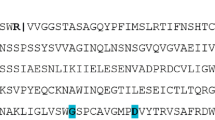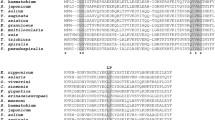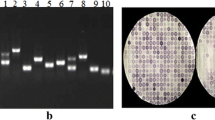Abstract
Cercariae of Plagiorchis elegans secrete a serine proteinase from their penetration glands. The enzyme hydrolyzes both azocoll and gelatin at the optimal pH of 8.4 but is incapable of hydrolyzing elastin at the pH range of 7.2-10.0 Ca2+ and Mg2+ activate it, whereas metal chelators (1 mM EGTA, lmM EDTA) and serine proteinase inhibitors ( 1 mM PMSF and 0.1 mM DFP) act as strong inhibitors. The proteinase activity is insensitive to thiol-blocking compounds and to 5 mM 1,10-phenan-throline, a relatively specific chelator of zinc. It appears, therefore, that the active proteinase represents a metal-enzyme complex rather than a metalloenzyme. Being capable of hydrolyzing N-blocked L-alanine-1-naphthylester, N-blocked L-methionine-1-naphthylester, and naphthyl AS-D chloroacetate at pH 6.8, the proteinase is insensitive to 1 mM p-nitrophenyl phosphate, an inhibitor of some mammalian esterproteinases. The enzyme does not split N-blocked DL-phenylalanine-2-naphthylester, nonspecific esterase substrates (1-naphthyl acetate, 1-naphthyl butyrate, 5-bromoindoxyl acetate), or several TV-blocked L-aminoacyl- and TV-blocked L-peptidyl-naph-thylamides bearing L-arginine, L-alanine, L-phenylala-nine, L-leucine, or L-proline at the P1 subsite. At operative pH values of 4.8 and 3.8 generated during electrophoresis in a stacking and a resolving gel, respectively, the cercarial proteinase migrates toward the cathode. The separated enzyme produces three bands of proteolysis in a gelatin-containing polyacrylamide gel at the optimal pH of 8.4. The presence of the proteinase in the penetration glands, in the secretory canals, and in the secretion from the glands suggests that the enzyme facilitates penetration, thus enabling the larvae to force their way through tissues of their hosts.
Similar content being viewed by others
Abbreviations
- MOPS:
-
3-(morpholino)propane-acid sulfonic
- Z-Ala-Onap:
-
N-benzyloxycarbonyl-L-alanine-1-naphthylester
- Ac-Met-Onap:
-
N-acetyl-L-methionine-1-naphthylester
- ClAc-OnapAS-D:
-
3-hydroxy-2-naphthyl-o-toluidide chloroacetate
- pHMB:
-
sodium p-hydroxymercuribenzoate
- NEM:
-
N-ethylmaleimide
- DFP:
-
diisopropyl fluorophosphate
- PMSF:
-
phenylmethanesulfonyl fluoride
- pNPP:
-
sodium p-nitrophenyl phosphate
- EDTA:
-
ethylenediaminetetraacetic acid
- EGTA:
-
ethylene glycol-O,O′-bis(2-aminoethyl)-N,N,N′,N′-tetraacetic acid
- DTE:
-
dithioerythritol TRIS tris(hydroxymethyl)aminomethane
- BSA:
-
bovine serum albumin
- MES:
-
2-(morpholino)ethane sulfonic acid
- TPCK:
-
tosyl-L-phenylalanine chloromethyl ketone
- TLCK:
-
Nα-tosyl-L-lysine chloromethyl ketone
- ACA:
-
ε-aminocaproic acid
- SBTI:
-
soybean trypsin inhibitor
- Bz-Phe-Onap:
-
N-benzoyl-DL-phenylalanine-2-naphthylester
References
Amiri P, Sakanari J, Basch P, Newport G, McKerrow JH (1988) The Schistosomatium douthitti cercarial elastase is biochemically and structurally distinct from that of Schistosoma mansoni. Mol Biochem Parasitai 28:113–120
Chavez-Olortegui C, Resende M, Tavares CAP (1992) Purification and characterization of a 47 kDa protease from Schistosoma mansoni cercarial secretion. Parasitology 105:211–218
Dresden MH, Edlin EM (1974) Schistosoma mansoni: effect of some cations on the proteolytic enzymes of cercariae. Exp Parasitai 35:299–303
Hjertén S (1962) “Molecular sieve” chromatography on polyacrylamide gels, prepared according to a simplified method. Arch Biochem Biophys [Suppl 1]: 147–151
Holt SJ, Withers RFJ (1952) Cytochemical localization of esterases using indoxyl derivatives. Nature 170:1012–1014
Le Flore WB (1979) Histochemical observations on hydrolytic enzymes in cercariae of Plagiorchis elegans, with notes on morphology of nervous system. Trans Am Microsc Soc 98:225–232
Lexow U, Großbarth C, Deimling O von (1979) Histochemical demonstration of mouse submandibular esterproteases with a new chromogenic substrate. Histochemistry 60:327–334
Lojda Z, Gossrau R, Schiebler TH (1979) Enzyme histochemistry. A laboratory manual. Springer, Berlin Heidelberg New York
Matsumura K, Shimada M, Sato K, Aoki Y (1990) Praziquantel-induced secretion of proteolytic enzyme from Schistosoma mansoni cercariae. J Parasitai 76:436–438
McKerrow JH, Pino-Heiss S, Lindquist R, Werb Z (1985) Purification and characterization of an elastinolytic proteinase secreted by cercariae of Schistosoma mansoni. J Biol Chem 260: 3703–3707
Moczon T (1994a) A cysteine proteinase in the cercariae of Diplostomum pseudospathaceum (Trematoda, Diplostomatidae). Parasitai Res 80:680–683
Moczon T (1994b) Histochemistry of proteinases in the cercariae of Diplostomum pseudospathaceum (Trematoda, Diplostomatidae). Parasitai Res 80:684–686
Peterson GL (1983) Determination of total protein. Methods Enzymol 91:95–119
Ravin HA, Bernstein P, Seligman AM (1954) A colorimetric micromethod for the estimation of chymotrypsin activity. J Biol Chem 208:1–15
Reisfeld R, Lewis U, Williams D (1962) Disc electrophoresis of basic proteins and peptides on polyacrylamide gels. Nature 195:281–283
Schaller E, Deimling O von (1979) Methionine-α-naphthyl ester, a useful chromogenic substrate for esterproteases of the mouse submandibular gland. Anal Biochem 93:251–256
Schechter I, Berger A (1967) On the size of the active site in proteases. I. Papain. Biochem Biophys Res Commun 27:157–162
Schotton DM (1970) Elastase. Methods Enzymol 19:113–140
Smith RE, Frank RM van (1975) The use of amino acid derivatives of 4-methoxy-β-naphthylamine for the assay and subcellular localization of tissue proteinases. In: Dingle JT, Dean RJ (eds). Lysosomes in biology and pathology, vol 4. North-Holland, Amsterdam, pp 193–249
Starkey PM, Barrett AJ (1976) Human lysosomal elastase. Catalytic and immunological properties. Biochem J 155:265–271
Sweetman F, Ornstein L (1974) Electrophoresis of elastase-like esterases from human neutrophils. J Histochem Cytochem 22: 327–339
Author information
Authors and Affiliations
Additional information
This work was supported by a satutable grant from the State Committee for Scientific Research to the Parasitology Institute
Rights and permissions
About this article
Cite this article
Moczon, T. A serine proteinase in the penetration glands of the cercariae of Plagiorchis elegans (trematoda, plagiorchiidae). Parasitol Res 82, 72–76 (1996). https://doi.org/10.1007/s004360050071
Received:
Accepted:
Issue Date:
DOI: https://doi.org/10.1007/s004360050071




